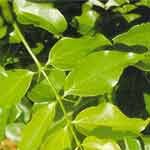| Common Name: |
Poison Nut |
| Other Names: |
Strychnine, Nux-Vomica |
| Botanical Name: |
Strychnos nux-vomica |
| Genus: |
Strychnos |
| Family: |
Loganaceae |
| Cultivation: |
Well-drained, rich soil in sun or partial shade. |
| Native Location: |
India and Myanmar (Burma) |
| Propagation: |
By seed sown in spring; by semi-ripe cuttings in summer. |
| Harvest: |
Seeds are collected when ripe, and dried for elixirs, liquid extracts, pills, or tinctures, and for commercial extraction of alkaloids. |
| Height: |
20m (70ft) |
| Width: |
15m (50ft) |
| Hardiness: |
Min. 15°C (59°F) |
| Parts Used: |
Seeds |
| Properties: |
A very bitter, tonic herb that stimulates the nervous system and improves appetite. |
| Medicinal Uses: |
Internally in minute amounts, for nervous exhaustion, debility, and poor appetite (especially in the elderly and children). It is also used as a central nervous system stimulant in chloroform or chloral poisoning, surgical shock, and cardiac arrest. Used (as nux-vomica) in homeopathic preparations. |
| Economic Uses: |
Strychnine is extracted commercially for use in vermin poisons. |
| Warning: |
All parts are toxic; handle with care;
Excess causes paralysis (notably risus sardonicus, a fixed grin), convulsions, respiratory failure, and death.
Used by qualified practitioners only; This herb and strychnine are subject to legal restrictions in most countries. |
| Bibliography: |
Encyclopedia of Herbs by Deni Brown Copyright © 1995, 2001 Dorling Kindersley Limited. pp 376 |

